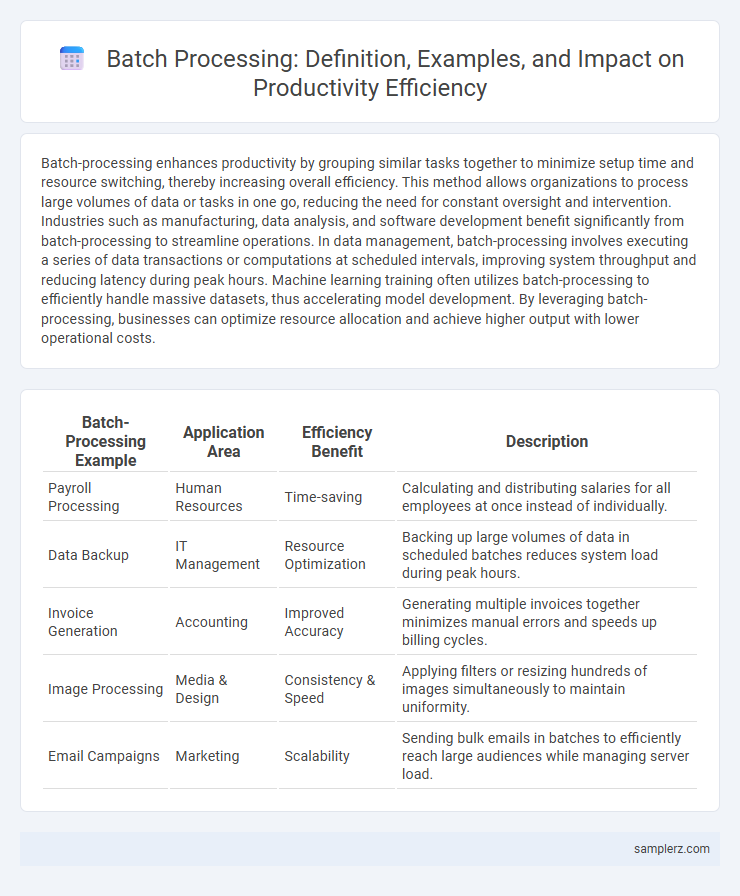Batch-processing enhances productivity by grouping similar tasks together to minimize setup time and resource switching, thereby increasing overall efficiency. This method allows organizations to process large volumes of data or tasks in one go, reducing the need for constant oversight and intervention. Industries such as manufacturing, data analysis, and software development benefit significantly from batch-processing to streamline operations. In data management, batch-processing involves executing a series of data transactions or computations at scheduled intervals, improving system throughput and reducing latency during peak hours. Machine learning training often utilizes batch-processing to efficiently handle massive datasets, thus accelerating model development. By leveraging batch-processing, businesses can optimize resource allocation and achieve higher output with lower operational costs.
Table of Comparison
| Batch-Processing Example | Application Area | Efficiency Benefit | Description |
|---|---|---|---|
| Payroll Processing | Human Resources | Time-saving | Calculating and distributing salaries for all employees at once instead of individually. |
| Data Backup | IT Management | Resource Optimization | Backing up large volumes of data in scheduled batches reduces system load during peak hours. |
| Invoice Generation | Accounting | Improved Accuracy | Generating multiple invoices together minimizes manual errors and speeds up billing cycles. |
| Image Processing | Media & Design | Consistency & Speed | Applying filters or resizing hundreds of images simultaneously to maintain uniformity. |
| Email Campaigns | Marketing | Scalability | Sending bulk emails in batches to efficiently reach large audiences while managing server load. |
Understanding Batch Processing: A Productivity Game-Changer
Batch processing boosts productivity by grouping similar tasks to minimize downtime and resource switching, significantly increasing output efficiency. For example, in manufacturing, assembling multiple orders simultaneously reduces setup time and cost per unit. Software development teams use batch processing to run multiple test scripts together, streamlining workflows and accelerating project timelines.
Key Benefits of Batch Processing for Workplace Efficiency
Batch processing streamlines repetitive tasks by grouping similar activities, significantly reducing setup time and minimizing manual intervention. This method enhances workflow continuity and ensures consistent output quality, leading to higher productivity rates within the workplace. Key benefits include time savings, resource optimization, and the ability to handle large volumes of data or tasks efficiently.
Common Examples of Batch Processing in Daily Tasks
Batch processing boosts productivity by handling multiple tasks simultaneously, such as processing payroll, generating bank statements, and updating inventory records. These common examples enable organizations to optimize resource usage and reduce manual effort. Automating repetitive tasks in batches improves accuracy and speeds up overall workflow completion.
How Businesses Boost Output Through Batch Processing
Businesses boost output through batch processing by grouping similar tasks or transactions, such as invoice generation or product assembly, to be completed simultaneously, reducing setup times and minimizing downtime. This method optimizes resource allocation and streamlines workflows, enabling companies to process high volumes efficiently while maintaining quality. Batch processing software like ERP systems and automated workflows further enhance productivity by enabling accurate tracking and faster turnaround times.
Batch Processing in Email Management: Streamlining Communication
Batch processing in email management enhances productivity by grouping similar tasks like sorting, labeling, and responding to emails into designated time blocks, reducing constant context switching. This method leverages automated filters and templates to handle repetitive emails quickly, allowing employees to focus on more strategic work. Companies report a 30% increase in email handling efficiency and reduced cognitive load by implementing batch processing systems.
Automating Repetitive Tasks with Batch Processing Tools
Batch processing tools significantly enhance productivity by automating repetitive tasks such as data entry, file conversions, and report generation. These tools execute multiple jobs sequentially without manual intervention, reducing errors and saving time. Implementing batch processing workflows streamlines operations and maximizes resource utilization in business environments.
Batch Processing Applications in Manufacturing and Industry
Batch processing in manufacturing enhances productivity by grouping similar tasks to minimize machine setup time and reduce downtime. Applications include pharmaceutical production, where precise batch control ensures consistent quality, and automotive assembly lines that optimize workflow through scheduled batches. This method streamlines operations, cuts costs, and enables scalable production with improved resource management.
Time-Saving Batch Processing Techniques for Remote Workers
Batch processing techniques like scheduling email responses and automating routine data entry significantly reduce task-switching time for remote workers. Grouping similar tasks into focused time blocks minimizes distractions and maximizes deep work periods, enhancing overall productivity. Utilizing tools such as Zapier or Microsoft Power Automate streamlines workflows by handling repetitive tasks, saving valuable hours daily.
Maximizing Project Workflow with Batch Processing Strategies
Batch processing enhances project workflow efficiency by grouping similar tasks to minimize downtime and streamline operations. Utilizing automated batch processing tools reduces manual intervention, allowing teams to focus on higher-value activities and accelerate project timelines. Implementing batch strategies in software development, data analysis, or content creation optimizes resource allocation and improves overall productivity.
Real-World Success Stories: Batch Processing for Peak Efficiency
Batch processing significantly enhanced Amazon's order fulfillment by automating large-scale data handling to streamline inventory management and shipping. Walmart leverages batch processing to update pricing and stock availability across thousands of stores simultaneously, minimizing downtime and errors. In manufacturing, General Electric uses batch processing to optimize production schedules and quality control, resulting in reduced operational costs and faster turnaround times.

example of Batch-processing in efficiency Infographic
 samplerz.com
samplerz.com